- Obecnie brak na stanie
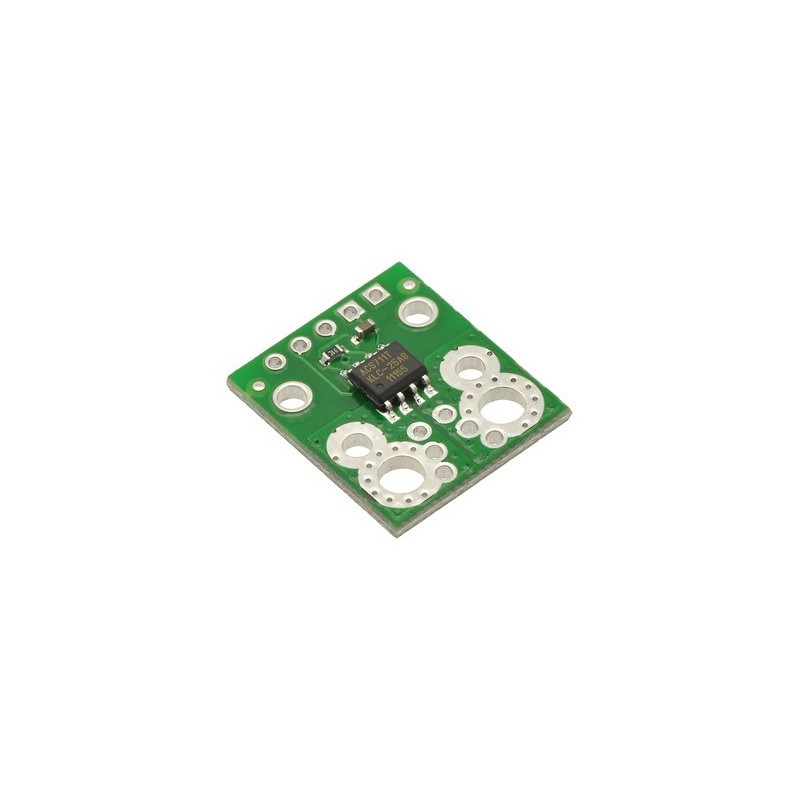
ACS711 Current Sensor Carrier -25 to +25A
This board is a simple carrier of Allegro’s ±25A ACS711 Hall effect-based linear current sensor with overcurrent fault output, which offers a low-resistance (~1.2 m?) current path and electrical isolation up to 100 V. This version accepts a bidirectional current input with a magnitude up to 25 A and outputs a proportional analog voltage centered at Vcc/2 with a typical error of ±5%. It operates from 3 to 5.5 V, so it can interface directly to both 3.3 V and 5 V systems.
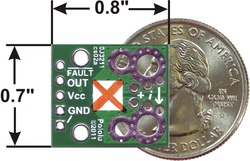 |
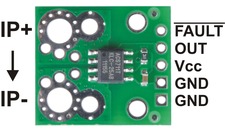 |
This current sensor is a carrier board or breakout board for Allegro’s ACS711KLCTR-25AB-T Hall effect-based linear current sensor with overcurrent fault output; we therefore recommend careful reading of the ACS711 datasheet (489k pdf) before using this product. The sensor has an operating voltage of 3 – 5.5 V and an output sensitivity of 55 mV/A when Vcc is 3.3 V (or 83 mV/A when Vcc is 5 V). The following list details some of the sensor’s key features:
The pads are labeled on the bottom silkscreen, as shown in the picture to the right. The silkscreen also shows the direction that is interpreted as positive current flow via the +i arrow.
This 25 A current sensor is marked with a orange X. We also sell a 12.5 A version that uses the same carrier PCB; you can distinguish the versions by reading the text on the IC or by looking at the color of the X on the bottom silkscreen.
The sensor requires a supply voltage of 3 – 5.5 V to be connected across the Vcc and GND pads, which are labeled on the bottom silkscreen. The sensor outputs an analog voltage that is linearly proportional to the input current. The quiescent output voltage is Vcc/2 and changes by 55 mV per amp of input current (when Vcc = 3.3 V), with positive current increasing the output voltage and negative current decreasing the output voltage. For an arbitrary input current i (in amps), the sensor’s output voltage can be more generally represented as:
VOUT = (0.055 V/A * i + 1.65 V) * Vcc / 3.3 V
The FAULT pin is normally high and latches low when the current exceeds ±25 A. Once the FAULT pin is latched low, the only way to reset it is by toggling power on the Vcc pin.
|
|
The input current can be connected to the board in a variety of ways. Holes with 0.1?, 3.5 mm, and 5 mm spacing are available as shown in the diagram above for connecting male header pins or terminal blocks. For high-current applications, you can solder wires directly to the through-holes that best match your wires, or you can use solderless ring terminal connectors, as shown in the picture above. The large through-holes are big enough for #6 screws.
The board has two mounting holes on the logic side of the board. These mounting holes are 0.5" apart and are designed for #2 screws.
This board ships assembled with all surface mount components, and a 5?1 strip of 0.1? header pins is included but not soldered in, as shown in the picture below.
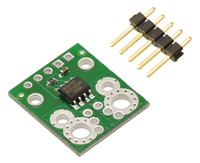 |
| ACS711 current sensor carrier with included 5 ? 1 0.1? header pins. |
|---|
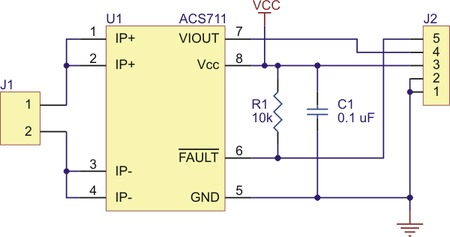 |
| ACS711 current sensor carrier schematic diagram. |
|---|
 |
ACS714 Current Sensor Carrier -5 to +5A |
 |
MinIMU-9 Gyro, Accelerometer, and Compass (L3G4200D and LSM303DLM Carrier) |
 |
ACS709 Current Sensor Carrier -75 to +75A |
Producent BTC Korporacja sp. z o. o. Lwowska 5 05-120 Legionowo Polska sprzedaz@kamami.pl 22 767 36 20
Osoba odpowiedzialna BTC Korporacja sp. z o. o. Lwowska 5 05-120 Legionowo Polska sprzedaz@kamami.pl 22 767 36 20
Wyświetlacz graficzny 128x64, 54x50m, podświetlaniem EL (white), Pb-Free, FSTN positive, cztery symbole zamiast czterech pixeli, niski pobór prądu
Brak towaru
Brak towaru
Zestaw startowy wyposażony w mikrokontroler STM32F411RE (512 kB Flash, Cortex-M4), z programatorem-debugerem ST-Link/v2. Zmodyfikowana wersja kompatybilna z oryginalnym Nucleo. Waveshare XNUCLEO-F411RE
Brak towaru
Brak towaru
Brak towaru
Brak towaru
Brak towaru
Obudowa ochronna dedykowana do robota edukacyjnego micro:Maqueen Lite. Wykonana z ABS, w kolorze zielonym. DFRobot FIT0883-G
Brak towaru
Moduł z układem dwukierunkowego konwertera poziomów logicznych PCA9306, konwersja 1.0-3.6V oraz 1.8-5.5V, komunikacja poprzez interfejs I2C oraz SMB. SparkFun BOB-11955
Brak towaru
Brak towaru
Brak towaru
2-kanałowe zabezpieczenie głośników - zestaw do samodzielnego montażu
Brak towaru
Brak towaru
Brak towaru
Brak towaru
Komputer z procesorem Intel Celeron N4100, 4GB RAM oraz 32GB eMMC. Wyposażone w Wi-Fi, Bluetooth 4.0, Ethernet oraz Intel HD Graphics. Może obsługiwać dysk SSD. Posiada wsparcie dla Windows 10 oraz Linux. DFRobot DFR0543
Brak towaru

ACS711 Current Sensor Carrier -25 to +25A
